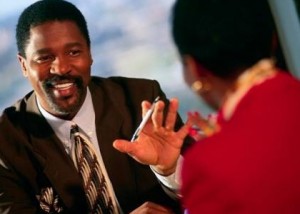G.E.’s Beth Comstock made a great post over on LinkedIn about communication and the intricacies of actually being involved in a conversation. Facilitating good communication has been a large part of my career ever since I started working. However, my consulting experience is where I’ve been most deeply involved with helping people hear what one another are saying.
My work with Intulogy, Exardius, and ConciER have all involved situations where I’ve needed to either be the focus of a conversation, or I’ve needed to sit by quietly and watch how a conversation unfolds, and either influence it or report back on my findings. In both cases, I’ve seen what research–and Beth–hints at; a large percentage of communication occurs non-verbally and in many cases, most people spend their time formulating a response to a comment that has yet to leave the speaker’s lips.
To see what I’m talking about, if you’re able, take a moment during the next meeting you’re in. Sit quietly and observe what happens. Watch as a conversation unfolds in front of you. In all likelihood, what you’ll see happen is the “listener” proverbially sitting on the edge of his seat while the speaker is speaking, just waiting to shoot back a response to her. The problem with this approach is rooted in how the mind works with conscious and unconscious thoughts–or more accurately, our controlled and automatic thought processes.
Beth notes in her article–a great one about Active Listening–that in business we pride ourselves on our ability to multi-task. The key problem is that human beings are pretty terrible multi-taskers, especially in this case. Your automatic mind tends to operate very quickly, out of your awareness, and is prone to things like biases and stereotypes, whereas your controlled mind operates more slowly, deliberately. and within your awareness, allowing you to counteract those biases. But, when your conscious mind has the most problems keeping your automatic mind from causing you problems is when it’s being taxed by your being tired, or when you’re trying your best to multi-task.
So, when you’re watching a conversation unfold like this, and you witness that person trying to listen and formulate a response at the same time, he’s more likely to apply any biases and stereotypes to his response. However, if he uses Active Listening like Beth points out, he’s going to force his controlled mind to take over and evaluate what’s says, and not allow his automatic mind color how he receives her message. When she says, “I’m a world-class multi-tasker but I grudgingly admit that I’m a more effective listener when focused,” that’s the focus she’s talking about
Ultimately, listening actively is more like playing catch with someone, than it is like juggling. Imagine trying to play catch while you’re juggling. There’s probably only a handful of people in the world who can do that effectively and those people are making a great living in the circus or on the Las Vegas strip. However, almost anyone can catch a ball, transfer it to their on-hand, and then toss it back. And if you can play catch effectively that way, versus constantly dropping balls trying to get one back to your partner, why wouldn’t you?
So, next time you get into a conversation, work to be a world-class catch-player; don’t try to be a mediocre juggler.
Photo: © sherrie smith | Dreamstime.com


